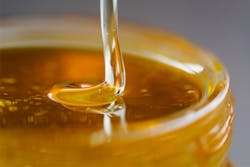What is the approximate viscosity of honey in centipoise (cP)?
A. 1 cP
B. 10 cP
C. 100 cP
D. 1,000 cP
E. 10,000 cP
A quick internet search shows that the viscosity of honey is 10,000 cP at a room temperature of 21.1°C. More research reveals that blended flower honey has a viscosity of approximately 12,200 cP at the same temperature. The first viscosity appears to be a generic estimate whereas the second refers to a specific commercially available product.
Answer E appears to be correct.
Additional complicating factors
Not so fast! Viscosity can be described as the ability of a fluid to flow over itself, and it can be highly dependent on temperature. Honey in a jar will flow at room temperature, albeit slowly. However, the ability of the honey to flow after it is cooled in a refrigerator is greatly diminished. Conversely heating the honey to (say) 50°C will greatly reduce its viscosity and improve its ability to flow. Higher water content will similarly reduce the viscosity of honey. Answer D may be possible in some applications.
Therefore, when someone asks for or cites the viscosity of a fluid, it is prudent to ask for the composition and temperature to which it applies.
David W. Spitzer is a regular contributor to Flow Control magazine and a principal in Spitzer and Boyes LLC, which offers engineering, seminars, strategic, marketing consulting, distribution consulting and expert witness services for manufacturing and automation companies. Spitzer and Boyes is also the publisher of the Industrial Automation INSIDER. He has more than 40 years of experience and has written more than 10 books and 350 articles about flow measurement, instrumentation and process control.
Spitzer may be reached at 845-623- 1830 or via spitzerandboyes.com. Click on the "Products" tab to find his Consumer Guides to various flow and level measurement technologies.
About the Author
David W. Spitzer
David W Spitzer’s new book Global Climate Change: A Clear Explanation and Pathway to Mitigation (Amazon.com) adds to his over 500 technical articles and 10 books on flow measurement, instrumentation, process control and variable speed drives. David offers consulting services and keynote speeches, writes/edits white papers, presents seminars, and provides expert witness services at Spitzer and Boyes LLC (spitzerandboyes.com or +1.845.623.1830).
